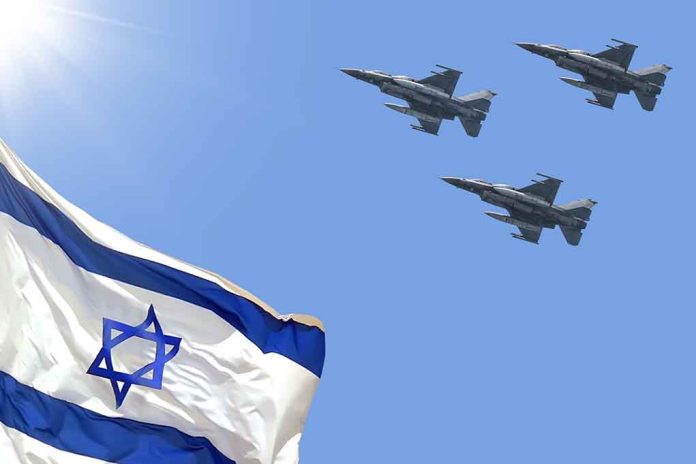
Israel’s precision strike has eliminated Iran’s intelligence chief and his deputy, marking a devastating blow to Tehran’s security apparatus and dramatically escalating the Middle East conflict.
Key Takeaways
- Israeli forces have killed Iranian Intelligence Chief Brig. Gen. Mohammad Kazemi and his deputy Hassan Mohaqiq in a targeted operation
- Israel has conducted widespread strikes on Iranian military infrastructure, including Basij paramilitary headquarters and weapons production facilities
- Iran launched dozens of ballistic missiles at Israel in retaliation, but they caused no significant damage
- Reports indicate Tehran residents are fleeing the city amid fears of continued Israeli strikes
- Israel appears to have near-complete operational freedom over Iranian airspace following destruction of air defenses
Israeli Military Deals Devastating Blow to Iranian Intelligence Leadership
The Israel Defense Forces (IDF) has successfully eliminated Iran’s intelligence chief Brigadier General Mohammad Kazemi and his deputy Hassan Mohaqiq, according to confirmations from both Israeli and Iranian state media. This precision strike represents an extraordinary intelligence achievement for Israel and a crippling setback for Iran’s security apparatus. The killing of such high-ranking officials demonstrates Israel’s remarkable intelligence penetration into the Iranian regime and signals a significant escalation in the ongoing conflict between the two nations.
The strategic operation extended far beyond targeting intelligence leadership. Israeli forces conducted extensive strikes against the headquarters of the Basij, a notorious paramilitary organization responsible for violently suppressing civilian uprisings within Iran. The destruction of this headquarters could potentially embolden Iranian citizens who have long suffered under the regime’s brutal tactics. Additionally, the IDF struck Quds Force infrastructure, Iranian Revolutionary Guard Corps facilities, and numerous weapons production sites across Iran.
🚨 ISRAEL HITS IRANIAN AERIAL REFUELING AIRCRAFT AND STRIKES IRGC INTELLIGENCE LEADERSHIP IN MASHHAD
💥 In a significant escalation, the Israeli Air Force carried out a long-distance strike targeting an Iranian aerial refueling aircraft at Mashhad Airport, located approximately… pic.twitter.com/YMoyRmPJ1i
— Israel Realtime (@IsraelRealtime) June 15, 2025
Iran’s Ineffective Retaliation and Civilian Exodus
In response to Israel’s devastating strikes, Iran launched dozens of ballistic missiles toward Israeli territory. However, these retaliatory measures proved largely ineffective, causing no significant damage or casualties. This failed counterattack further highlights the growing military disparity between the two nations. Israeli sources indicate that the IDF has achieved near-complete operational freedom over Iranian airspace following the systematic destruction of Iran’s air defense systems, leaving Tehran increasingly vulnerable to continued precision strikes.
As military tensions escalate, videos circulating on social media appear to show Tehran residents fleeing the capital city in significant numbers. The exodus reflects growing fear among Iranian civilians that Israel will continue targeting strategic sites within Tehran and other major cities. Traffic jams have been reported on highways leading out of the capital as families seek safety from potential future strikes. This civilian movement represents a tangible manifestation of the regime’s diminishing ability to protect its population and maintain stability.
Strategic Implications and Regional Impact
Israel’s targeting of the Basij headquarters carries significant strategic implications beyond the immediate military impact. The Basij force has been the regime’s primary tool for violently suppressing domestic opposition and civilian protests. Its weakening could potentially create space for renewed anti-government activity within Iran at a time when the regime is already struggling to maintain control amid growing international isolation, economic hardship, and now direct military vulnerability.
The successful elimination of Iran’s intelligence leadership represents a severe operational and morale blow to Tehran’s security apparatus. Intelligence chiefs maintain critical networks of assets and information channels that cannot be easily replaced. Their removal disrupts Iran’s ability to gather intelligence, coordinate proxy operations across the Middle East, and detect future Israeli operations. This development significantly shifts the regional balance of power in Israel’s favor as the conflict continues to intensify.
Israel’s Operational Freedom and Future Prospects
Perhaps most concerning for Iran is Israel’s apparent domination of Iranian airspace. With air defenses severely degraded, Israel now possesses unprecedented freedom to conduct additional operations against strategic targets throughout Iran. This capability dramatically alters the strategic calculus for Tehran, as even the regime’s most sensitive installations – including nuclear facilities – now exist under perpetual threat of precision strikes that Iran seemingly cannot prevent.
As residents flee Tehran and the Iranian military struggles to respond effectively, President Trump’s strong support for Israel has provided strategic clarity in the region. The decisive Israeli action against Iranian military infrastructure demonstrates the consequences of Iran’s continued aggression and proxy warfare tactics. With Israel displaying both the intelligence capabilities to identify high-value targets and the military prowess to eliminate them with precision, Iran now faces difficult decisions about its path forward in a conflict where it finds itself increasingly outmatched.



